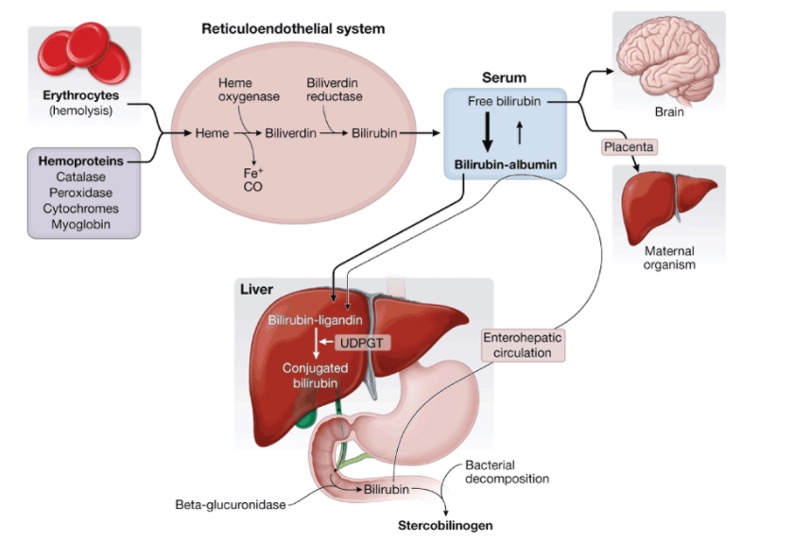Definition of Bilirubin
Bilirubin is a chemical that is generated when red blood cells and other porphyrin-containing cells are broken down. Red blood cells include special molecules known as hemes (a form of porphyrin) that contain an iron atom. This configuration permits the red blood cell to transport oxygen. When blood cells degrade, heme is released into the blood, which can be harmful if not regulated.

As shown in the figure above, heme is actively broken down in the liver. It is first converted into biliverdin. Another enzyme completes the reaction by converting biliverdin to bilirubin which is transported to intestines by the bile duct. It might then be eliminated in the urine or the feces. It is metabolized in the intestines to stercobilin, a reddish-brown protein that gives feces their characteristic color. Bilirubin is converted to urobilin, a highly yellow chemical, in the urine.
Bilirubin is a natural pigment since it is connected to porphyrin molecules. It changes hue as it transforms into other molecules and variations. These hues can be used by scientists to detect disease. A bruise, for example, is created by blood infiltration beneath the skin. Pooling blood has a dark crimson or purple color that will gradually turn brownish as the iron oxidizes.
The heme groups must be broken down as the blood is withdrawn and recycled. Heme is first transformed to biliverdin, a greenish tinted compound. This is why a huge bruise that one gets usually appears greenish. It is then transformed to bilirubin, which has a unique yellow color. Before vanishing, old bruises will turn this unique yellow. Bilirubin’s distinctive yellow color is a typical indication of illnesses such as jaundice, in which bilirubin accumulates all over the body.
This can occur in babies whose livers have not yet fully matured, as well as in adults with non-functioning livers. While the yellow coloration of the eyes and skin is a clear indication that something is seriously wrong, a bilirubin test can detect bilirubin levels before they become problematic.
Bilirubin is also produced in plants as a breakdown product of chlorophyll, a molecule that is very similar to the heme molecules found in animal cells. It’s also quite similar to the pigment phycobilin, which autotrophic bacteria use to harvest sunlight energy.
Bilirubin Test
Unconjugated vs Conjugated Bilirubin
In your blood, bilirubin can take several forms. It exists in a water-soluble form that is linked to glucuronic acid by a specific enzyme in the liver. This is known as conjugated bilirubin and makes bilirubin easier to detect. Unconjugated bilirubin, on the other hand, is fat-soluble and therefore difficult to detect in solution. As a result, some bilirubin is undetected. It forms bonds with itself as well as other fat-loving molecules.
As a result, a total bilirubin test comprises both the direct measurement of soluble bilirubin and the predicted indirect bilirubin. These two types, and their abundance in the system, can tell a doctor a lot about which processes in the liver may be disrupted.
A healthy person, for example, will have a higher concentration of unconjugated bilirubin, but the exact quantities will vary depending on the person and circumstance. Normal total bilirubin levels range from 0.1 to.1.2 milligram per deciliter (mg/dL) of blood, while direct bilirubin levels range from 0.1 to 0.4 mg/dL. Hyperbilirubinemia, or an extremely high bilirubin level, can occur for a variety of reasons.
The total blood bilirubin level would have to be much higher than this for this condition to manifest. Symptoms of bilirubin accumulation, such as jaundice of the eyes and skin, are often apparent at 10 mg/dL which is over ten times the normal values. It could be caused by a rapid loss of blood cells, a non-functioning liver, or a number of other conditions that prevent the liver or other organs from correctly processing bilirubin.
This disease could also be caused by a bile duct obstruction, hepatitis, or some medicines that interfere with bilirubin transit or conversion. As your bilirubin levels can signal a variety of illnesses, your doctor will order a battery of further testing.
Urine Bilirubin Test
Bilirubin is not generally excreted in the urine of healthy people. Normally, it is transformed to another compound that is considerably more water soluble. Bilirubin in the urine is a symptom of a multitude of disorders affecting the liver, kidneys, and/or intestines in which a biological process is disrupted. Finding bilirubin in the urine might assist a doctor determine where the error is occurring in the excretory system. Many factors will contribute to this, including the type of bilirubin discovered and its quantity.
Related Questions
1. What causes bilirubin to be yellow and biliverden to be green?
- A. The structure of their bonds
- B. The amount of energy they emit
- C. It’s their preferred color!
2. What is the connection between chlorophyll, heme, and bilirubin?
- A. Nothing
- B. They’re all pigments
- C. They are all porphyrin rings
3. After birth, newborn newborns frequently become “jaundiced,” or exceedingly yellow. Why is this the case?
- A. They are genetically incapable of processing bilirubin
- B. The liver is not yet fully developed
- C. It is completely natural and harmless
References
Bruice, P. Y. (2011). Organic Chemistry (6th ed.). Boston: Prentice Hall.
https://www.mayoclinic.org/tests-procedures/bilirubin/about/pac-20393041
https://www.hepatitis.va.gov/hcv/patient/diagnosis/labtests-bilirubin.asp





